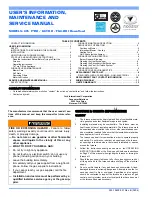
440 01 4201 03
5
Specifications subject to change without notice.
Duct Systems
US and CANADA: Air Conditioning Contractors
Association (ACCA) Manual D, Sheet Metal and Air
Conditioning Contractors National Association
(SMACNA), or American Society of Heating,
Refrigeration, and Air Conditioning Engineers (ASHRAE)
2005 Fundamentals Handbook Chapter 35.
Acoustical Lining and Fibrous Glass
Duct
US and CANADA: current edition of SMACNA, NFPA
90B as tested by UL Standard 181 for Class I Rigid Air
Ducts
Gas Piping and Gas Pipe Pressure
Testing
U.S.A.: NFPA 54/ANSI Z223.1
−
2009, NFGC; Chapters
5, 6, 7, and 8 and national plumbing codes.
CANADA: CAN/CSA
−
B149.1
−
2010, Parts 4, 5, 6 and
9.
In the state of Massachusetts:
This product must be installed by a licensed plumber or
gas fitter.
When flexible connectors are used, the maximum
length shall not exceed 36
−
in. (914 mm).
When lever type gas shutoffs are used they shall be
T
−
handle type.
The use of copper tubing for gas piping is not
approved by the state of Massachusetts.
Electrical Connections
U.S.A.: National Electrical Code (NEC) ANSI/NFPA
70
−
2011
CANADA: Canadian Electrical Code CSA C22.1
Electrostatic Discharge (ESD)
Precautions Procedure
!
CAUTION
FURNACE RELIABILITY HAZARD
Failure to follow this caution may result in unit component
damage.
Electrostatic discharge can affect electronic components.
Take precautions during furnace installation and servicing to
protect the furnace electronic control. Precautions will pre-
vent electrostatic discharges from personnel and hand tools
which are held during the procedure. These precautions will
help to avoid exposing the control to electrostatic discharge
by putting the furnace, the control, and the person at the
same electrostatic potential.
1. Disconnect all power to the furnace. Multiple
disconnects may be required. DO NOT TOUCH THE
CONTROL OR ANY WIRE CONNECTED TO THE
CONTROL PRIOR TO DISCHARGING YOUR BODY’S
ELECTROSTATIC CHARGE TO GROUND.
2. Firmly touch the clean, unpainted, metal surface of the
furnace chassis which is close to the control. Tools held
in a person’s hand during grounding will be satisfactorily
discharged.
3. After touching the chassis, you may proceed to service
the control or connecting wires as long as you do nothing
to recharge your body with static electricity (for example;
DO NOT move or shuffle your feet, do not touch
ungrounded objects, etc.).
4. If you touch ungrounded objects (and recharge your
body with static electricity), firmly touch a clean,
unpainted metal surface of the furnace again before
touching control or wires.
5. Use this procedure for installed and uninstalled
(ungrounded) furnaces.
6. Before removing a new control from its container,
discharge your body’s electrostatic charge to ground to
protect the control from damage. If the control is to be
installed in a furnace, follow items 1 through 4 before
bringing the control or yourself in contact with the
furnace. Put all used and new controls into containers
before touching ungrounded objects.
7. An ESD service kit (available from commercial sources)
may also be used to prevent ESD damage.
Accessories
See Specification Sheets for a list of accessories for this
product.
Table 2
Loose Parts Bag Contents
(shipped in blower compartment)
QUANTITY
COMPONENT NAME
1
Air Intake Pipe Flange
1
Vent Pipe Flange
2
Coupling Flange Gaskets
10
Sharp Tip Screws (Vent and Inlet Flanges)
1
Vent Pipe Coupling
2
Vent Pipe Coupling Clamps
1
Rubber Drain Tube
4
Drain Tube Clamps
1
1/2” CPVC to 3/4” PVC Pipe Adapter
1
Gas Line Grommet
1
Junction Box Cover
1
Junction Box Base
1
Green Ground Screw
3
Blunt Tip Screws (Junction Box)
1
Thermostat Wire Grommet
Provided separately in furnace
1
Drain Extension Tube
−
“Z” Pipe






































